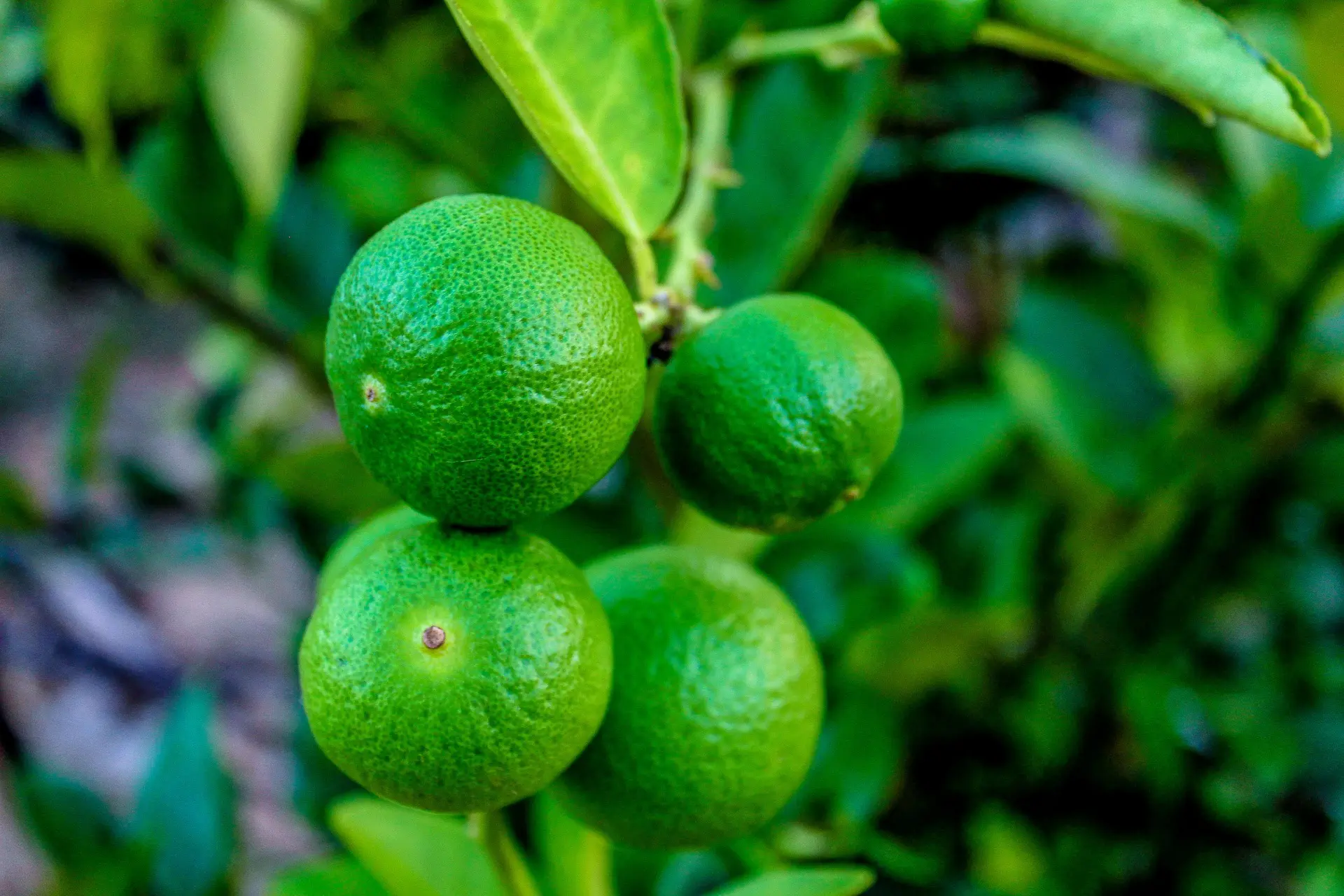This post contains affiliate links. If you buy something from one of our links we may earn a commission. Thanks
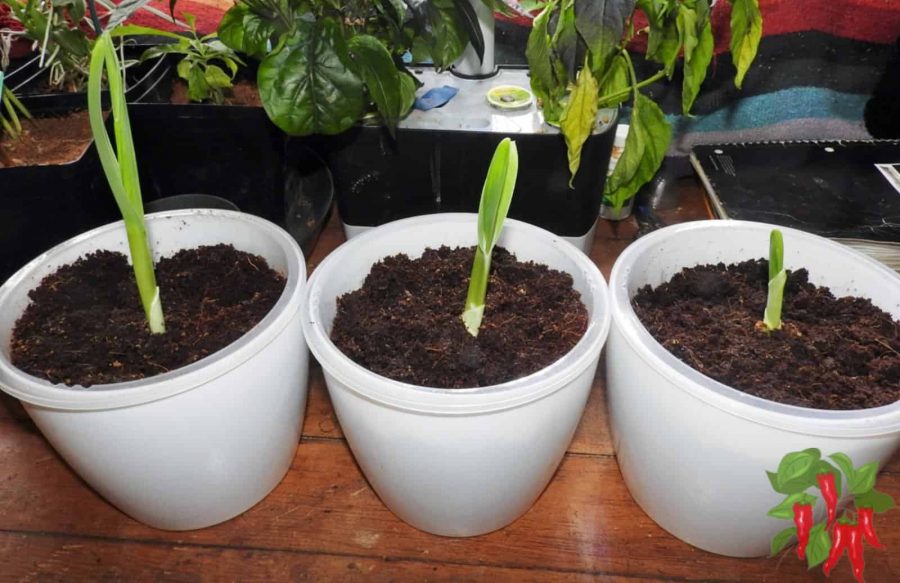
Self-watering plant pots are a game changer for gardening enthusiasts and plant lovers alike.
Self-watering plant pots work by using a water reservoir at the bottom of the pot and a wicking system made of porous material. The wick draws water from the reservoir to the soil as it dries, providing a consistent supply of water to the plant. This eliminates the need for daily watering and reduces the risk of over-watering.
These innovative pots make it easy to keep your plants hydrated, healthy and thriving, even when you’re away from home or just busy with other things.
But how exactly do self-watering plant pots work?
In this blog post, we’ll take a closer look at the technology behind these self-watering containers, and explore the benefits, uses, and tips for getting the most out of your self-watering plant pot.
We will take a look at some of the best self-watering planters too. Whether you’re a seasoned gardener with a green thumb or just starting to explore the world of indoor gardening, this post is sure to provide valuable insights and inspiration.
What Are Self-Watering Plant Pots
Self-watering plant pots, also known as wicking pots, are a type of container gardening that utilizes a water reservoir and a wicking system to provide plants with water as they need it.
Self-watering planters are also sometimes called SIPs or sub-irrigated planters and you can read more about them here.
A water reservoir is located at the bottom of the pot and is filled with water. The wicking system, typically made of a porous material such as felt or cotton, draws water from the reservoir up to the soil as the soil becomes dry.
This allows the plants to have a consistent supply of water without the need for daily watering or worry about over-watering.
This type of pot is perfect for those who are busy and often travel, or for those who want to make sure their plants are always hydrated.
Self-Watering Pot Benefits
There are several benefits to using self-watering plant pots. Some of the main benefits include:
Convenience: With a self-watering pot, you can set it up and forget it. The wicking system will automatically provide water to the plant as it needs it, so you don’t have to worry about remembering to water your potted plant every day.
Better for plants: Consistent watering is essential for the health of most plants. With a self-watering pot, the plant will have access to water whenever it needs it, which can lead to healthier growth and healthy plants have a greater ability to withstand stress.

Save time and money: Self-watering planters require less frequent watering, which can save you time and money on water bills.
Additionally, self-watering containers can reduce the chance of over-watering, which can lead to root rot and other problems in your favorite plants.
Less water usage: Because water is stored in the reservoir and the plant is able to take water as it needs, it reduces the water usage and there is less evaporation.
Save space: Self-watering pots are great for small spaces or areas with limited water resources. They allow you to grow plants in areas that might not otherwise be suitable for gardening.
Easy maintenance: Self-watering pots are relatively low maintenance and easy to use. They are perfect for people who are new to gardening or who want to keep their gardening simple and easy.
The Basics Of Self-Watering Plant Pots
Self-watering plant pots provide a convenient and efficient way to keep plants hydrated.
These pots are designed to automatically provide water to the plants as they need it, so you don’t have to worry about remembering to water them every day.
The key components of a self-watering pot are the water reservoir system and the wicking system.
In this section, we’ll take a closer look at the basics of these two components, and explain how they work together to keep your plants healthy and thriving.
Understanding the water reservoir and the wicking system is essential for the proper use of a self-watering pot, and this knowledge will help you to make the most of this convenient gardening tool.
Explanation of the water reservoir
The water reservoir is the key component of a self-watering pot. It is located at the bottom of the pot and is used to hold water for the plant.
The reservoir can be filled manually, or it can be connected to a water source such as a hose or irrigation system.
The water reservoir is typically made of a durable, water-resistant material such as plastic or ceramic. Some reservoirs have an overflow hole and some do not.
Explanation of the wicking system
The wicking system is what allows the water from the reservoir to be drawn up to the soil.
It is typically made of a porous material such as felt, or cotton, that sits in the water reservoir and extends up into the soil.
As the soil becomes dry, the wicking system draws water from the reservoir up to the soil, providing the plant with the water it needs.
This system works by capillary action, which is the ability of a liquid to flow in narrow spaces without the assistance of, and in opposition to external forces like gravity.
The wicking system is designed to be as simple as possible, and it can be made from a variety of materials, including felt, cotton, or polyester.
The choice of material depends on the intended use of the pot. Some self-watering pots use a wick made of a synthetic material, which is more durable and resistant to mold and mildew.
Other wicks are made of natural materials, which are more biodegradable and environmentally friendly. However, they need to be replaced periodically.
How Do Self-Watering Plant Pots Work?
Self-watering plant pots are a great way to keep your plants hydrated and healthy, but how exactly do they work?
In this section, we will delve into the details of how the water reservoir, the wicking system, and the plants interact to keep the plant’s roots hydrated.
We’ll explore the process of how water is drawn from the reservoir to the soil, how the wicking system regulates the amount of water delivered so plants don’t get too much water, and how the water level in the reservoir tells when to refill.
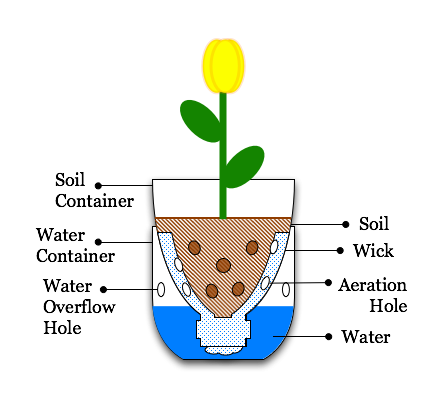
Understanding how self-watering plant pots work will help you to make the most of this convenient gardening tool, troubleshoot any issues that may arise, and ensure that your plants receive the right amount of water at the right time.
The water is drawn up from the reservoir to the soil
Self-watering plant pots use a wicking system to draw water from the reservoir at the bottom of the pot up to the soil.
As mentioned this is done through a process called capillary action.
The wicking system, typically made of a porous material such as felt or cotton, sits in the water reservoir and extends up to the soil.
As the soil becomes dry, the wicking system draws water from the reservoir up to the soil, providing the plant with the water it needs.
The wicking system regulates the amount of water delivered
The wicking system is designed to regulate the amount of water delivered to the soil, ensuring that the plant receives the right amount of water at the right time.
The wicking system is able to adjust the rate of water delivery based on the moisture level of the soil so that the plant never receives too much or too little water.
This allows the plant to absorb water as it needs it and prevents over-watering or under-watering.
The water level in the reservoir tells when to refill
The water level in the reservoir is an indicator of when the reservoir needs to be refilled.
The water level can be checked manually by looking at the water level in the reservoir or by using a water level indicator.
Some self-watering plant pots have a built-in water level indicator, which alerts you when the water level is low and it’s time to refill the reservoir.
Some don’t and you will need to lift the inner pot to check the water level.
Either way, it’s easy to maintain the proper water level in the reservoir, ensuring that the plant always has access to the water it needs.
Advantages Of Self-Watering Plant Pots
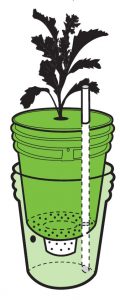
Self-watering plant pots are a convenient and efficient way to keep your plants hydrated and healthy, but the benefits don’t stop there.
These pots offer a number of advantages over traditional gardening methods, making them a great choice for anyone looking to simplify their gardening routine.
In this section, we will explore some of the key advantages of using self-watering plant pots, including convenience, better for plants, saving time and money, less water usage, saving space, and easy maintenance.
Understanding these advantages will help you to make the most of your self-watering pot and ensure that your plants receive the care they need to thrive.
Convenience: set it and forget it
One of the main advantages of self-watering plant pots is convenience. These pots are designed to automatically provide water to the plants as they need it, so you don’t have to worry about remembering to water them every day.
A self-watering system is especially useful for people who are busy and often travel, or for those who want to make sure their plants are always hydrated.
With a self-watering pot, you can set it up and forget it, knowing that your plants will receive the water they need even when you’re not around to water them.
Better for plants: more consistent watering
Consistent watering is essential for the health of most plants. With a self-watering pot, the plant will have access to water whenever it needs it, which can lead to healthier growth and a greater ability to withstand stress.
The wicking system is designed to regulate the amount of water delivered to the soil, ensuring that the plant receives the right amount of water at the right time. This allows the plant to absorb water as it needs it and prevents over-watering or under-watering.
Save time and money: no need to water as frequently
Self-watering planters require less frequent watering, which can save you time and money on water bills.
Additionally, they can reduce the chance of over-watering, which can lead to root rot and other problems.
The water reservoir in the pot can store a good amount of water, that can last for a week or more, depending on the size of the reservoir and the rate of water usage of the plant.
This means less time spent watering and more time spent enjoying your garden.
How To Choose A Self-Watering Plant Pot
Self-watering plant pots are a great choice for anyone looking to simplify their gardening routine, but with so many different options available, it can be difficult to know which one to choose.
In this section, we will explore some of the key factors to consider when choosing a self-watering plant pot, including size, material, and the type of plant you want to grow.
Understanding these factors will help you to choose a self-watering pot that is best suited to your needs, and ensure that your plants receive the care they need to thrive.
Whether you’re a seasoned gardener or just starting to explore the world of indoor gardening, this section will provide valuable insights and inspiration.
Size of the pot:
The size of the pot is an important factor to consider when choosing a self-watering pot. The size of the pot will determine how much soil and how many plants you can fit into it.
It’s important to choose a pot that is the right size for the plants you want to grow, as well as for the space where you plan to put it.
If you’re planning to grow small herbs or succulents, a small pot will be sufficient, but if you’re planning to grow larger plants, such as tomatoes or cucumbers, you’ll need a larger pot.
Many systems use an inner and outer pot. The inner pot has drainage holes through which the wick is inserted into the growing medium.
The inner pot sits in the outer pot which serves as the reservoir. Some reservoirs have a water indicator and some need to be checked manually.
Material of the pot:
The material of the pot is also an important factor to consider. Self-watering pots can be made from a variety of materials, including plastic, ceramic, or terracotta.
Each material has its own advantages and disadvantages, and the choice of material will depend on your preferences and the intended use of the pot.
Plastic pots are lightweight and inexpensive, but they can crack or warp over time.
Ceramic pots are more durable and can last for many years, but they are also heavier and more expensive.
Terracotta pots are inexpensive, and they look great, but they can dry out quickly, so pots made from porous materials might not be the best choice for self-watering pots.
If you like the look of terra cotta or ceramic pots in your living room you can use larger ones as exterior pots and place your self-watering planting container inside them.
Type of plant you want to grow:
The type of plant you want to grow is also an important factor to consider when choosing a self-watering pot.
Some plants prefer more moist soil, while others prefer drier soil. It’s important to choose a pot that is suitable for the type of plant you want to grow and that will provide the right environment for it to thrive.
Choosing the right self-watering plant pot can be a bit tricky, but by considering the size, material, and type of plant you want to grow, you can be sure to choose the right one for your needs.
Potting Mix
The potting mix you use is important to success. It can be used to control moisture levels inside the pot. It needs to be able to maintain a consistent moisture level without holding excess water.
I have found coco coir offers superior wicking and good water retention without getting waterlogged and is a better alternative than peat-based potting soil.
Plant roots simply love growing in coco coir. You can adjust the moisture level by adding perlite to your coco but usually, this is not needed for most indoor plants.
The exception might be to grow cacti or succulents in a self-watering system. For plants like these, you can use a 50/50 coco perlite mix or even just LECA pebbles.
Fertilizing
You will want to use liquid fertilizers that are mixed with water in the reservoir. Because plants are being fed constantly you will want to use half-strength fertilizer.
Do not add dry fertilizer on top of the soil as it will burn the plant.
However, if the reservoir is empty you can add your half-strength liquid fertilizer to the top but be careful you don’t overfill your reservoir.
The Best Self-Watering Planters
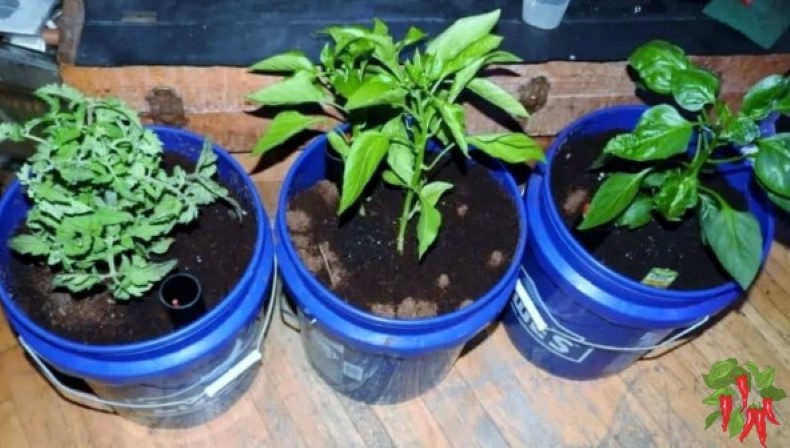
If you want to grow larger plants the GroBucket is one of the best self-watering planters. It uses larger containers and is made from 5-gallon buckets.
It has a bottom reservoir and a special insert to keep the water and soil separate but touching and in direct contact.
It does not use wicks which can not always supply enough water for larger thirsty plants. The reservoir of water is larger which means filling less often.
It has an easy-to-access PVC piper fill tube that holds a float so you always know what the water level is and when to add more.
In addition, there is an overflow hole near the bottom of the planter so you can’t overwater your plants.
They can be used indoors and outdoors. They are perfect for large plants like tomatoes or other large houseplants. For more information, you can read my GroBucket Review.
For smaller plants I like and use these: DELF 6 Pack 6.7″ Self-Watering Planters Flower Pots. They are inexpensive and work well for smaller plants.
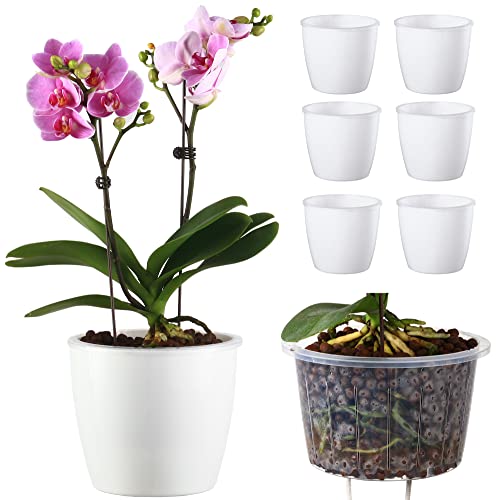 I have used them with LECA for orchids and coco coir for strawberries and elephant garlic. There’s no drain hole and you have to check the reservoir manually but it is easy to do and only takes a second to do.
I have used them with LECA for orchids and coco coir for strawberries and elephant garlic. There’s no drain hole and you have to check the reservoir manually but it is easy to do and only takes a second to do.
Self-Watering Pots FAQs
Self-watering plant pots are a boon for busy gardeners and those who travel frequently.
They offer a convenient way to keep your plants hydrated without the daily hassle of watering.
However, you might have questions about how they work, what plants are best suited for them, how to set them up, and how to maintain them.
Let’s dive into some frequently asked questions to clear up any uncertainties.
Q. How do self-watering plant pots work?
A: Self-watering plant pots have a water reservoir at the bottom and a wicking system made of porous material. The wick draws water from the reservoir to the soil, providing a consistent supply of water to the plant.
Q. What types of plants are best suited for self-watering pots?
A: Plants that prefer consistent moisture levels, like herbs and many houseplants, are well-suited for self-watering pots. However, plants that prefer dry conditions, like succulents and cacti, may not be the best fit.
Q. How do I set up a self-watering plant pot?
A: To set up a self-watering pot, fill the water reservoir at the bottom, place the wicking system, and then add soil and your plant. Make sure the wick is in contact with both the water and the soil for effective watering.
Q. How do I maintain my self-watering plant pot?
A: Maintenance involves periodically refilling the water reservoir and checking the wick for any signs of mold or deterioration. Some pots come with a water level indicator, making it easier to know when to refill.
Final Thoughts
In conclusion, self-watering plant pots are a convenient and efficient way to keep your plants hydrated and healthy.
Self-watering pots work plain and simple. These pots use a water reservoir and a wicking system to provide plants with water as they need it and can save you time, money, and water.
In this blog post, we have covered the basics of how self-watering plant pots work, the advantages they offer, how to choose the right one, and how to take care of them.
We have discussed the water reservoir, the wicking system, and the mechanism of how they work together to keep the plants hydrated.
Additionally, we have covered how the wicking system regulates the amount of water delivered and how the water level in the reservoir tells when to refill.
We hope that this blog post has provided you with valuable insights and inspiration for using self-watering plant pots.
We encourage you to try using one of these innovative pots for yourself and see the benefits it can bring to your gardening routine.






